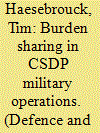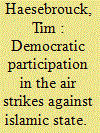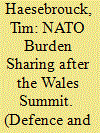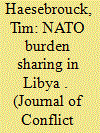|
|
|
Sort Order |
|
|
|
Items / Page
|
|
|
|
|
|
|
| Srl | Item |
| 1 |
ID:
162547


|
|
|
|
|
| Summary/Abstract |
Military burden sharing has been a subject of repeated debates in NATO and the UN. Despite more modest goals, the European Union’s (EU) Common Security and Defense Policy (CSDP) has experienced no fewer difficulties in garnering men, money, and materiel. While this may not come as a surprise, the fact that some EU member states have carried disproportionate shares of the burden of CSDP operations is a puzzle that remains unaccounted for. We address this gap by analyzing determinants of contribution levels to CSDP operations. In employing an innovative multi-method design that combines insights from collection action theory with those from integrated theories of military burden sharing, our results indicate that EU countries tend to contribute in positive disproportion with their capabilities when they have a strong peacekeeping tradition and elections are distant. In contrast, they undercontribute when small trade volumes with the area of operations combine with a weak peacekeeping tradition.
|
|
|
|
|
|
|
|
|
|
|
|
|
|
|
|
| 2 |
ID:
159582


|
|
|
|
|
| Summary/Abstract |
Although over sixty partners have joined the US-led coalition against the Islamic State (IS), only a handful of states was willing to carry out air strikes against IS-targets. This article aims to explain the pattern of democratic participation in the air campaign. It builds on the rich literature on military burden sharing and democratic peace theory to develop a multi-causal model, which is tested with Qualitative Comparative Analysis. The results of the analysis suggest that the pattern of participation in the air strikes results from a complex interplay between alliance politics, threat perception and domestic institutional constraints. The threat posed by foreign fighters and a strong interest in a good relationship with the US constituted important incentives to participate in the air strikes, while a high level of parliamentary involvement in military deployment decisions inhibited participation. Furthermore, states that were situated in Russia's immediate vicinity refrained from participating, in spite of their strong dependence on the US' security guarantee. Lastly, the analysis did not provide convincing evidence that partisan politics had an impact on participation in the air strikes.
|
|
|
|
|
|
|
|
|
|
|
|
|
|
|
|
| 3 |
ID:
157528


|
|
|
|
|
| Summary/Abstract |
Contrary to what the EU’s image as a civilian power suggests, the EU member states have had 50,000–100,000 troops deployed outside their home countries for most of the post-Cold-War period. Although the vast majority of these troops were active in operations with a strong European presence, the member states’ patterns of military engagement differ significantly. This study provides a systematic analysis of the member states’ contributions to military operations. More specifically, it examines which (combinations of) conditions consistently led to participation in EUFOR Congo, UNIFIL II, EUFOR Chad, the 2011 military intervention in Libya and the air strikes against the Islamic State. Methodologically, it builds on most different similar outcome/most similar different outcome and qualitative comparative analysis. The results of the analysis show that four conditions account for the bulk of the member states’ patterns of military engagements: military resources, competing deployments, UN peacekeeping tradition and regional trade.
|
|
|
|
|
|
|
|
|
|
|
|
|
|
|
|
| 4 |
ID:
186521


|
|
|
|
|
| Summary/Abstract |
At the 2014 Wales Summit, the NATO allies pledged to spend at least 2% of their GDP on defence by 2024. While some allies are on track to meet the 2% target, others only modestly augmented their military expenditures and still others have even reduced their defence budgets. This article aims to explain the diverging trajectories of the allies’ military expenditures during the first five years after the Wales Summit. More specifically, it introduces an integrated burden sharing model, which is tested with generalized set Qualitative Comparative Analysis. The results of the analysis indicate that the threat posed by Russia provided the most important incentive for increasing defence budgets. However, general budget constraints kept some allies from increasing their defence budget in proportion to the threat posed by Russia. Conversely, in the absence of budget constraints, allies governed by a right-leaning executive made intermediate budget efforts even if they only faced a low level of threat. Strikingly, budget inertia only had a modest impact on the allies’ defence budgets, only resulting in a low level of spending in allies that were not threatened by Russia and either faced considerable budget constraints or were governed by a left-wing government.
|
|
|
|
|
|
|
|
|
|
|
|
|
|
|
|
| 5 |
ID:
156541


|
|
|
|
|
| Summary/Abstract |
This study aims to explain the pattern of contributions to NATO’s military campaign in Libya. It combines collective action theory with hypotheses on balance of threat, alliance politics, and domestic constraints in a multicausal framework, which is tested with qualitative comparative analysis. The results suggest novel inferences on the interactions between partisan politics, and the benefits states wish to secure by contributing to a multilateral operation. Contrary to conventional wisdom, parties situated at the left of the ideological spectrum were more inclined to support Operation Unified Protector than parties situated at the right. Whereas left-wing governments participated if they had the resources to contribute significantly to the fulfillment of the protection mandate and either highly valued their alliance with the United States or were not facing imminent elections, right-wing governments only contributed if their countries’ interests were threatened by the crisis in Libya or their participation was critical for the operation’s success
|
|
|
|
|
|
|
|
|
|
|
|
|
|
|
|
| 6 |
ID:
186199


|
|
|
|
|
| Summary/Abstract |
While a comprehensive body of research provides evidence that politics does not always stop at the water’s edge, the question “when does politics stop at the water’s edge” has remained largely unanswered. This article addresses this gap in the literature by examining the level of agreement in Belgium’s parliament on military deployment decisions. More specifically, the uncontested decisions to participate in the 2011 Libya intervention and the air strikes against the self-proclaimed Islamic State in Iraq are compared with the contested decision to participate in strike operations against IS over Syrian territory. The results of our study indicate that a broad parliamentary consensus will emerge if the domestic political context forces left- and right-leaning parties into negotiating a compromise that takes into account their preferences regarding the scope of the operation and if left-leaning parties have no reason to oppose the operation because it pursues inclusive goals and its international legal justification is not contested.
|
|
|
|
|
|
|
|
|
|
|
|
|
|
|
|
| 7 |
ID:
168997


|
|
|
|
|
| Summary/Abstract |
Does public opinion act as a constraint on military action, are ordinary citizens the easily manipulated targets of the public relations efforts of their governments, or does the general public react as assertively to threats as decisionmakers? This article examines the causal connection between military action, public opinion and threats. Empirically, it focuses on the pattern of EU member state participation in two recent military operations: the 2011 intervention in Libya and the operation against the self-proclaimed Islamic State (IS). Three competing causal models on the relationship between threats, public opinion and military action were derived from the scholarly literature and tested with coincidence analysis. The results of the analysis show that public opinion acted as a constraint on executives during the Libya operation. However, there was no direct causal link between public opinion and military participation in the operation against IS, in which both military action and public support were an effect of threat. More generally, the results suggest that the context of the intervention is decisive for the relation between threat, military action and public support. More specifically, whether public opinion constitutes a constraint on military action or is an effect of threats to national interests depends on whether these threats are clear and tangible.
|
|
|
|
|
|
|
|
|
|
|
|
|
|
|
|
|
|
|
|
|